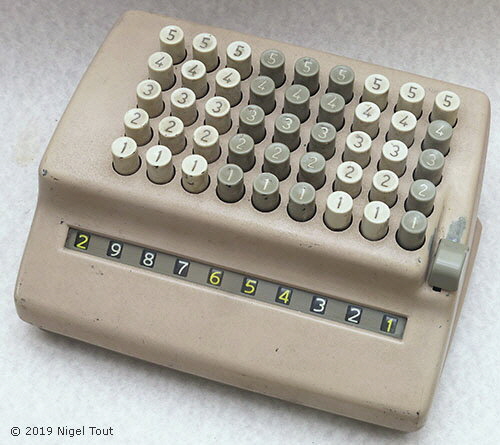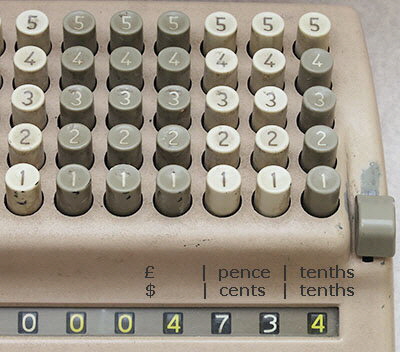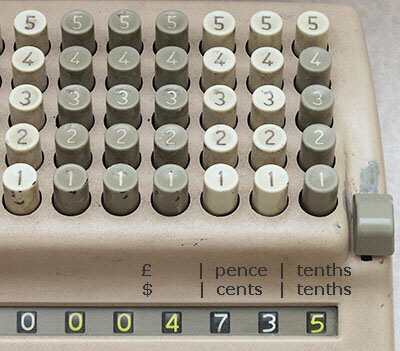Plus & Sumlock Mechanical Calculators
PLUS 509/LD

Plus model 509/LD
Decimal, key-driven ("Comptometer") type, with abbreviated keyboard (only has keys 1 to 5). To enter a number greater than 5 two keys have to be pressed in succession in that column. It also has a round-off feature.
It is a model 509/LD where the 5 denotes the abbreviated keyboard (keys up to 5), the 09 denotes the 9 columns of keys, and the D denotes a Decimal version.
Although no official information has come to light, it appears that the 'L' in the model type indicates that the machine has button colours configured to provide round-off. This is useful when working with the cost of items which are accurate to tenths of a penny or tenths of a cent, but we want the answer only to the nearest penny or cent.
On this machine the right-most column is for the tenths of pence or tenths of cents, the next two columns to the left are for pence or cents, and the rest of the columns are for £ or $, as shown in the example photographs below.
Calculations are carried out as usual using all of the keys. Then to round the calculation to the nearest penny or cent the '5' key in the tenths column is pressed (it is specially coloured the same as the two columns to its left). The rounded result can now be read off, ignoring the tenths values, as in the examples below. Note that the '5' key can be pressed at any time such as before commencing a calculation. This feature involves no extra mechanism, and only saves the operator having to do the 4/5 roundoff mentally.
The only difference between this 'LD' model and the normal decimal 'D' model appears to be in the colour of the keys. If you have official information about the 'LD' models please get in touch.
235 x 182 x 120 mm (9.25" x 7.2" x 4.75").
The machine illustrated has serial number 509/LD/878.686.
Made by Bell Punch Company Ltd., London, England.
Distributed in the United Kingdom by Sumlock Comptometer Ltd., 39, St. James's Street, London, S.W.1.
Example of rounding down to the nearest penny or cent.

Example of rounding up to the nearest penny or cent.

Above is shown the results of two calculations which only differ by one tenth penny or one tenth cent and we need to round each to the nearest penny or cent. To do this the '5' key in the tenths column is then pressed which performs the rounding and then the tenths value is ignored.
Here the 4 tenths in the result above have been rounded down to give £4.73 or $4.73.

Here the 5 tenths in the result above have been rounded up to give £4.74 or $4.74.

Note how the result digits are coloured to aid in the rounding with the tenths digit being a different colour to the pence or cents digits.
There are excellent photographs and descriptions of the Plus Adder mechanism at John Wolff's Web Museum site. These are accessed from the Comptometers and Key-Driven Calculators section on that site.
Plus & Sumlock Mechanical Calculators
Text & photographs copyright © 2002 - 2023 Nigel Tout, except where noted otherwise.